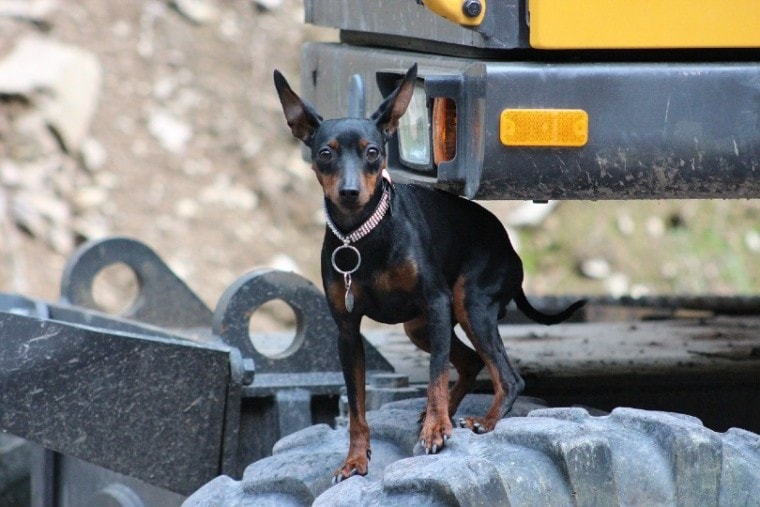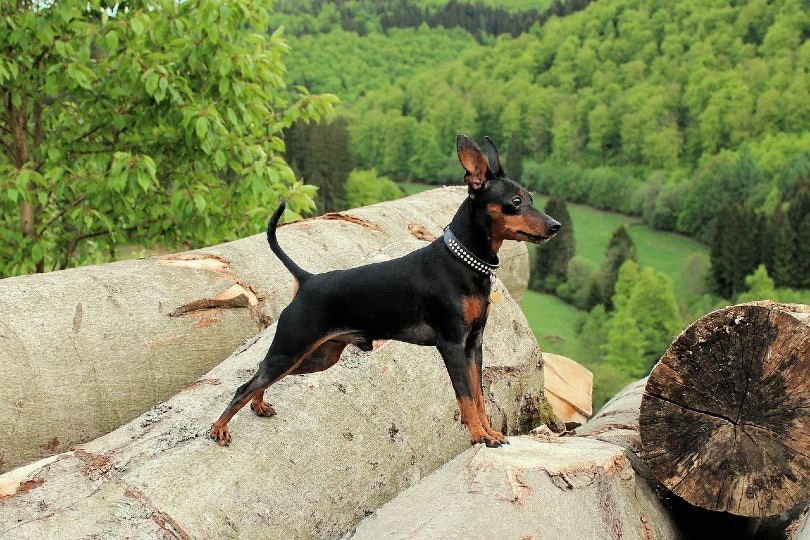
Click Below to Skip Ahead
The Miniature Pinscher, lovingly referred to as the Min Pin, is a little dog packed with personality. If you’re looking for a lapdog, this won’t be the breed for you. These feisty dogs are full of energy and attitude and they won’t let you forget it.
While this breed isn’t the lounging type, Min Pins do bond with their families and are affectionate with the people they love. Some don’t like strangers at all, while others can warm up to them over time.
Although small in stature, this dog will try their best to be your watchdog. Fearless and bold, they will alert you to anything new in their environment. The Min Pin is always on alert.
Breed Overview
Height:
10 – 12 inches
Weight:
8 – 11 pounds
Lifespan:
10 – 14 years
Colors:
Red, chocolate, fawn, black, grey, blue, tan, rust
Suitable for:
Active families, children over 10 years old, those looking for a lively dog
Temperament:
Affectionate, playful, clever, friendly, energetic, assertive, confident
There’s a reason that this dog is called the King of Toys. This toy breed will try to show you who’s boss. They are assertive and athletic. Training and socialization will help the Min Pin learn acceptable ways to behave.
When they’re feeling snuggly, you’ll find the Min Pin under any blankets that they can find. They love to burrow, always looking to be as warm as possible.
Let’s find out more about this charming breed.
Miniature Pinscher Characteristics
Miniature Pinscher Puppies
The price of Miniature Pinscher puppies varies dramatically depending on the breeder, coat color, and bloodline of the dog that you are purchasing.
If you are on the hunt for a very lively pup, then the Miniature Pinscher may be the dog for you. While they get on well with children, if your kid are older, that would be best.

Temperament & Intelligence of the Miniature Pinscher
These energetic and smart dogs love to learn new tricks and are quite playful. They are also loyal companions and bond with their families. They can be reserved and standoffish around new people and other dogs. They tend to prefer playing with dogs that are similar in size and energy level.
While small, Min Pins have minds of their own. They are independent and strong-willed. Training is required for these dogs, but even the best-trained dogs can never be allowed off of the leash in an unenclosed area. Min Pins have extremely high prey drives, and if they take off after a furry critter that runs by, there is no amount of calling them back to you that will work. It is dangerous to leave these dogs off-leash and unattended. Even in backyards, they are good escape artists and can figure out ways to get out of any enclosure.
Min Pins are intelligent and can learn basic commands. But they’re also stubborn when they want to be and are notoriously difficult to housetrain. Persistence is the key when it comes to any training. Positive training methods will work on these dogs with consistency and patience.
Are These Dogs Good for Families? 👪
Min Pins may be nervous around younger children and not get along with them well. For this reason, they are recommended for kids over 10 years old who know not to be rough with such a small dog.
Min Pins can be possessive and get nippy when someone tries to take something away. This could be food, toys, or a bone. If the Min Pin wants it, they will fight for it. This is another reason that Min Pins do best in a home with older kids who know not to touch their things.
Once your Min Pin feels comfortable in the home, their antics will start. This dog is a comedian and loves to be the center of attention. They bond to their families and love affection. While they aren’t lapdogs in a traditional sense, they will enjoy curling up next to you on the couch to watch a movie. As long as their exercise needs are met, they can contentedly cuddle with you.
Min Pins are known for being protective of their homes and families. For small dogs, they try to make themselves appear bigger when in protect mode and will not hesitate to bark.
Does This Breed Get Along With Other Pets?
Min Pins get along with other pets if they’ve been socialized with them properly or if they were raised with them in the same household from puppyhood. This breed prefers dogs of their own size. If they are around dogs larger than them, they may try to dominate them and be aggressive toward them.
While Min Pins have high prey drives, they can live with cats if introduced properly. They should not live in homes with rabbits, guinea pigs, ferrets, or small rodents. They were bred to kill rodents, and this could result in disaster. If the home has small animals that are allowed out of their enclosures, the Min Pins prey drive will take over. Be cautious of this if you are bringing a Miniature Pinscher into a home with small furry critters.
Things to Know When Owning a Miniature Pinscher
Food & Diet Requirements 🦴
Min Pins should be fed high-quality commercial dog food that is recommended for their age. If you have questions about how much or how often to feed them, there should be an explanatory feeding chart listed on the food bag or you can work with your vet to come up with a diet plan.
Min Pins are prone to being overweight. They are little dogs that are food motivated, so it’s easy to overfeed them. When training, giving them an excessive number of treats to get them to respond to commands can also help them pack on the pounds.
Be sure to watch your Min Pin’s weight, and only feed them the recommended amount of food per day.
Exercise 🐕
Miniature Pinschers are energetic, but they aren’t capable of going on long hikes or excursions. They prefer to burn off their energy in short bursts of playtime or walks. They should have about 60 minutes a day of playtime broken up into two to three sessions.
A bored Min Pin is a destructive Min Pin. Physical exercise is a must, but these dogs also like having a job to do. Puzzle games and toys will keep them entertained.

Training 🎾
Min Pins can be trained easily because they are intelligent. They can pick up on new things quickly and enjoy doing what’s asked of them. They’re food motivated, and you can keep their attention when you’re holding their favorite snack.
These athletic dogs also do well in agility training. This is an ideal way to keep them learning while giving them a fun way to burn off their energy and get exercise.
Grooming ✂️
Min Pins have short coats and don’t need haircuts. They require brushing around once a week to help loosen and remove dead hair. They tend to shed heavily, so brushing can keep the shedding under control.
Brushing their teeth with a toothpaste made for dogs and a soft toothbrush will help ward off dental disease. Regular nail trims are required to keep the nails from getting overgrown and causing paw injuries.
You can bathe these dogs as needed. When you notice that they start to have an odor or they’re dirty, a quick bath is something that they tolerate well. Be sure to dry the insides of their ears.
Health and Conditions 🏥
Serious Conditions:
Cervical Disc Disease: This occurs when a disc bulges and puts pressure on the spinal cord, causing pain and difficulty moving. In severe cases, it can cause paralysis. Surgery is sometimes recommended as treatment, but other, less-invasive options include painkillers, physical therapy, and acupuncture. Massive and water therapy may also be effective and provide the dog some relief.
Legg-Calve-Perthes Disease: The cause of this disease is unknown, but it’s believed to be caused by a lack of blood supply to the thigh bone. The lack of blood flow causes the head of the femur bone to die and the hip joint disintegrates. Pain medication and weight loss are recommended for minor cases. More serious cases require surgery.
Minor Conditions:
Patellar Luxation: A luxating patella means a dislocated kneecap. It occurs when the kneecap slides out of the groove that it normally rests in and needs to be put back in place. Sometimes, you can notice your dog kick their back leg out while they’re walking or skip for a few steps. Then, they will go back to walking normally. Depending on the severity of the issue, pain medication can be prescribed or surgery will be recommended to fix this condition.
Obesity: This condition is preventable but common in Min Pins. When dogs are overweight, it shortens their lifespan and can cause other diseases and conditions to occur. Keeping your Min Pin at the recommended weight is recommended to help them be as healthy as possible.
Male vs. Female
Male and female Min Pins are similar in appearance and personality. Whether you get a male or female puppy is a matter of personal preference. However, there are a few key differences to note.
Male Min Pins are difficult to housebreak and mark their territory. That means they lift their legs and pee on anything that they can. While training can eventually break them of this habit, it might be something that you have to deal with for a while. Neutering can also help curb this behavior, but it may not stop it completely. Males also tend to be more dominant and aggressive than females.
Female Min Pins can also be difficult to housetrain, but they won’t lift their legs and mark their territory on your furniture. They are a little more independent than males, but they will show affection to their owners and enjoy being near them.
3 Little-Known Facts About the Miniature Pinscher
1. Min Pins are not small Dobermans.
Miniature Pinschers resemble Doberman Pinschers in many ways except they are smaller. Some may think that these dogs are tiny Doberman Pinschers, but they are two different breeds. They both have a distant relation to the Old German Standard Pinscher, but that’s where their connection ends.
2. They have a distinct gait.
If you’ve ever seen a Min Pin prancing, you’ve noticed their “Hackney gait.” It’s a high-stepping walk that is named after that of the Hackey horse.
3. Min Pins were bred to hunt.
The Miniature Pinscher was bred to catch rodents in Germany and was not registered with the American Kennel Club until 1925. Before that, they were almost unheard of outside of Germany and Scandinavia. They still have a high prey drive today due to their ancestry.
Final Thoughts
Min Pins are affectionate, loyal, silly, and loving dogs. They’re smart and will keep you entertained with their tricks and playfulness. They don’t require much exercise and are happy to be at home with their families.
They can be wary of strangers but this can be overcome in time.
While Min Pins can be difficult to housetrain, they will eventually learn what you want them to do through positive reinforcement training and rewards. They can be stubborn but your persistence is the key.
They make wonderful companions for families or single adults. However, they tend to do best around older children. Younger kids can be too much for them to handle.
Whether you choose a male or female Min Pin, you will be getting a friend for life.
- You may also want to read: Miniature Schnaupin (Miniature Schnauzer & Pinscher Mix)
Featured Image Credit: Dorena Beckendorf, Pixabay








